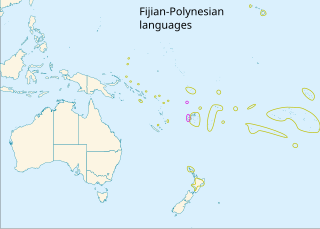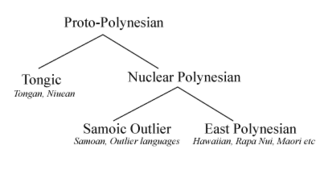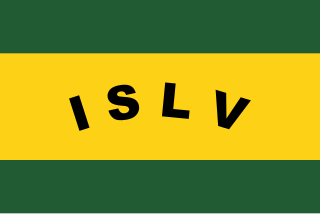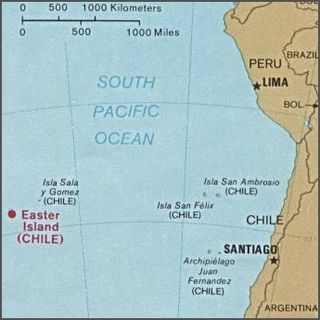The Tahitian Choir is a choral group from the island known as Rapa Iti, one of the Bass Islands in the South Pacific, approximately 1,000 miles southeast of Tahiti. The choir is made up of 126 men and women. Their music portrays their traditional Tahitian life and dialect and has been recorded on two albums and one re-release, recordings produced by Ethnomusicologist Pascal Nabet Meyer.

Easter Island is an island and special territory of Chile in the southeastern Pacific Ocean, at the southeasternmost point of the Polynesian Triangle in Oceania. The island is most famous for its nearly 1,000 extant monumental statues, called moai, which were created by the early Rapa Nui people. In 1995, UNESCO named Easter Island a World Heritage Site, with much of the island protected within Rapa Nui National Park.

Tahiti is the largest island of the Windward group of the Society Islands in French Polynesia. It is located in the central part of the Pacific Ocean and the nearest major landmass is Australia. Divided into two parts, Tahiti Nui and Tahiti Iti, the island was formed from volcanic activity; it is high and mountainous with surrounding coral reefs. Its population was 189,517 in 2017, making it by far the most populous island in French Polynesia and accounting for 68.7% of its total population.

The Polynesian languages form a genealogical group of languages, itself part of the Oceanic branch of the Austronesian family.
Tahitian is a Polynesian language, spoken mainly on the Society Islands in French Polynesia. It belongs to the Eastern Polynesian group.

The Austral Islands are the southernmost group of islands in French Polynesia, an overseas country of the French Republic in the South Pacific. Geographically, they consist of two separate archipelagos, namely in the northwest the Tupua'i islands consisting of the Îles Maria, Rimatara, Rūrutu, Tupua'i Island proper and Ra'ivāvae, and in the southeast the Bass Islands composed of the main island of Rapa Iti and the small Marotiri. Inhabitants of the islands are known for their pandanus fiber weaving skills. The islands of Maria and Marotiri are not suitable for sustained habitation. Several of the islands have uninhabited islets or rocks off their coastlines. Austral Islands' population is 6,965 on almost 150 km2 (58 sq mi). The capital of the Austral Islands administrative subdivision is Tupua'i.

Easter Island is located in the Pacific Ocean. Though its earliest inhabitants, the Rapa Nui People, are ethnically Polynesian, the island is part of the South American state of Chile. The music of the island combines influences from both cultures.
Rapa Nui or Rapanui, also known as Pascuan or Pascuense, is an Eastern Polynesian language of the Austronesian language family. It is spoken on the island of Rapa Nui, also known as Easter Island.
Rapa is the language of Rapa Iti, in the Austral Islands of French Polynesia, and of Mangaia in the Cook Islands. It is an Eastern Polynesian language. There are three varieties of the Rapa language currently being spoken in French Polynesia: Old Rapa, Reo Rapa and New Rapa. Old Rapa has been mostly replaced by Reo Rapa, a mix of the more commonly spoken Tahitian and Old Rapa. New Rapa – revitalized Old Rapa – is commonly spoken by middle-aged and younger speakers. Rapa is a critically endangered language, and there are only around 300 speakers of Reo Rapa, with only 15% of them able to speak Old Rapa. It may be more vibrant on Mangaia, but there the population has been declining for half a century due to emigration.

The Bass Islands consist primarily of Rapa Iti and Marotiri. They are usually considered to be the southernmost of the Austral Islands, although this classification is more one of geographic and political expediency than because of similarities between them and the rest of the Austral Islands. The Bass Islands, lying several degrees outside the tropics, are the southernmost islands in French Polynesia. Culturally, the Bass Islands appear to have been colonized about the same time as Tahiti and the Marquesas, and the culture and language (Rapan) appear to have diverged about the same time as well, indicating that they developed in relative isolation almost from the time of first settlement.

Rapa, also called Rapa Iti, or "Little Rapa", to distinguish it from Easter Island, whose Polynesian name is Rapa Nui, is the largest and only inhabited island of the Bass Islands in French Polynesia. An older name for the island is Oparo. The total land area including offshore islets is 40.5 km2 (15.6 sq mi). As of the 2017 census, Rapa had a population of 507. The island's highest point is at 650 metres (2,130 ft) elevation at Mont Perahu. Its main town is Ahuréi. The inhabitants of Rapa Iti speak their own Polynesian language called the Rapa language.

Nuclear Polynesian refers to those languages comprising the Samoic and the Eastern Polynesian branches of the Polynesian group of Austronesian languages.

The Leeward Islands are the western part of the Society Islands in French Polynesia, an overseas collectivity of France in the South Pacific. They lie south of the Line Islands, east of the Cooks and north of the Austral Islands. Their area is 395 km2 and their population is over 33,000.

Easter Island was traditionally ruled by a monarchy, with a king as its leader.
Mangareva, Mangarevan is a Polynesian language spoken by about 600 people in the Gambier Islands of French Polynesia and by Mangarevians emigrants on the islands of Tahiti and Moorea, located 1,650 kilometres (1,030 mi) to the North-West of the Gambier Islands.
The Rapa fruit dove is a species of bird in the family Columbidae, which includes pigeons and doves. It is endemic to the island of Rapa Iti in French Polynesia. The species was classified as Critically Endangered by the IUCN Red List in 2018 because of its small population and predicted continued decline. The Rapa fruit dove primarily feeds on fleshy fruit. Its natural habitat is subtropical or tropical moist lowland forests and it has an extent of 30 km2. It is threatened by habitat loss due to deforestation and invasive species. Effective land protection and management could increase the quality of habitat for the species. Additional research into population dynamics and the impact of threats to the species can give a better understanding of the conservation practices needed.

Geologically one of the youngest inhabited territories on Earth, Easter Island, located in the mid-Pacific Ocean, was, for most of its history, one of the most isolated. Its inhabitants, the Rapa Nui, have endured famines, epidemics of disease, civil war, environmental collapse, slave raids, various colonial contacts, and have seen their population crash on more than one occasion. The ensuing cultural legacy has brought the island notoriety out of proportion to the number of its inhabitants.

Bobby Holcomb (1947–1991) was an artist and musician who wrote popular Polynesian tunes.

This page list topics related to French Polynesia.
Viking Records was an independent record label that featured many New Zealand and Polynesian recording artists.

The Kingdom of Tahiti or the Tahitian Kingdom was a Polynesian monarchy founded by paramount chief Pōmare I, who, with the aid of British missionaries and traders, and European weaponry, unified the islands of Tahiti, Moʻorea, Teti‘aroa, and Mehetiʻa. The kingdom eventually annexed the Tuamotus, and the Austral Islands.